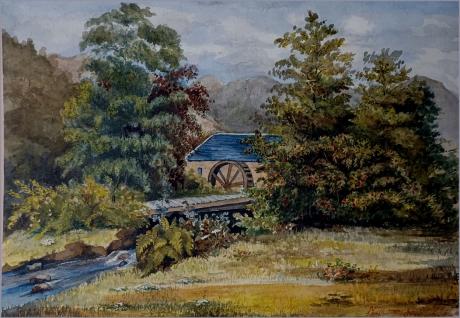signed inscribed and dated
The Trossachs (listen (help·info); Scottish Gaelic: Na Tròiseachan) generally refers to an area of wooded glens, braes, and lochs lying to the east of Ben Lomond in the Stirling council area of Scotland. The name is taken from that of a small woodland glen that lies at the centre of the area, but is now generally applied to the wider region.The wooded hills and lochs of the area may be considered to represent a microcosm of a typical highland landscape, and the woodlands are an important habitat for many species. Much of the Trossachs area is protected by various different conservation designations, including the Great Trossachs Forest National Nature Reserve.
The Trossachs form part of the Loch Lomond and The Trossachs National Park, which was established in 2002. The area has long been visited by tourists due to the relative proximity of major population centres such as Glasgow and Stirling, and remains popular with walkers, cyclists and tourists. Scenic boat rides on Loch Katrine are popular with visitors: the steamer SS Sir Walter Scott, launched in 1899, remains in operation. The Great Trossachs Path, one of Scotland's Great Trails, is a 48 km route suitable for walkers, cyclists and horse riders. It runs between Callander in the east and Inversnaid on the banks of Loch Lomond in the west, passing along the northern shores of Loch Katrine and Loch Arklet.
There are several prehistoric sites in the area, including a cup and ring marked rock and burnt mounds in Glen Finglas. There are crannogs on Loch Ard and Loch Venachar, and an Iron Age hill fort at Dunmore. The Trossachs were one of the first parts of Scotland to become a recognised tourist destination due to the area's position on the southern edge of the highlands and the quality of the scenery, which may be considered to represent a microcosm of a typical highland landscape. The poet William Wordsworth and his sister Dorothy visited the area, with Dorothy publishing an account of their visit in Recollections of a Tour Made in Scotland in 1803.
The scenic charms of the area came to popularity with Sir Walter Scott's 1810 poem The Lady of the Lake, extending his romantic portrayal of Scotland's past from border ballads to poems of a medieval past rich in chivalry and symbolism. The poem gives a roll call of Trossachs place names, the lady herself being found on Loch Katrine. Scott followed up with his 1817 historical novel Rob Roy romanticising the outlaw cattle thief Raibert Ruadh, who was born by Loch Katrine and buried at nearby Balquhidder.
The leading Victorian art critic John Ruskin (1819–1900) and the Pre-Raphaelite painter John Everett Millais (1829–1896) spent the summer of 1853 together at Glenfinlas in the Trossachs. Millais started a painting of John Ruskin during the visit, which he finished the following year. The painting is held in a private collection, but was on show at an exhibition on the Pre-Raphaelites at Tate Britain in London during 2004.John Ruskin himself was especially interested in the rock formations in the area and undertook his own studies of these.
The Trossachs Hotel was built on the north bank of Loch Achray in response to the growing number of tourists visiting the region. The building now functions as the Tigh Mor Trossachs holiday apartments, owned by the Holiday Property Bond (HPB).[18] In 1859, a dam was built at the eastern end of Loch Katrine and connecting aqueducts were added to as part of a new main water supply to Glasgow. At the expense of the Glasgow water company, Queen Victoria had a holiday house built overlooking the loch. The queen never stayed in the house, named Royal Cottage, as the windows were broken by the 21-gun salute that welcomed her,[19] and the cottage later became accommodation for the employees of Scottish Water.

